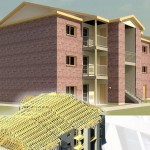 The building construction process from start to finish involves a lot of effort and investment. Consider that Utah is growing at a huge rate. At 1.64%, Utah currently enjoys the 4th highest growth rate in the country. As such, there are a lot of people coming to Utah and a lot of buildings are being built. But what exactly does “buildings being built” mean? Obviously, putting up a structure requires a lot of time and hard work, but what kind of hard work? Also, consider that constructing residential and commercial structures are both entirely different things.
The building construction process from start to finish involves a lot of effort and investment. Consider that Utah is growing at a huge rate. At 1.64%, Utah currently enjoys the 4th highest growth rate in the country. As such, there are a lot of people coming to Utah and a lot of buildings are being built. But what exactly does “buildings being built” mean? Obviously, putting up a structure requires a lot of time and hard work, but what kind of hard work? Also, consider that constructing residential and commercial structures are both entirely different things.
Careful planning must go into each aspect of building a structure. The planning has to start by asking: What is the structure’s purpose, utility and demand? Once those questions are answered, the construction process enters its first critical phase: the planning phase.
1. Planning
Planning might very well be one of the most important steps in building construction. The first step in construction planning involves acquiring a plot of land. Search for a location that is best suited for the building. Be careful selecting land which has all the desired facilities nearby but is riddled with land issues, whether it be zoning, soil or other problems you don’t want to suddenly have to deal with.
Consider a proper data collection regime as you plan your structure. Whether you do your own research online or hire someone, it is important that you have all the relevant information regarding the land you are about to purchase.
2. Get Technical Help
Hiring the right people to help you with construction is going to be an important part of the process. After selecting your land, you need to hire an architect to help with the building designs. Hiring an architect will also usually involve hiring an engineering firm to help you with the details. Whether it be structural engineering, civil engineering, land surveying or more, you need to hire true professionals like those here at McNeil Engineering.
It is usually after your work with the architect that you will hire a structural engineer. The structural engineer will handle the details from reinforcements to how deep your foundation will be to the size and type of gravel used, the width of your pillars and so on. Your structural engineer will play a critical role in ensuring your building doesn’t someday end up like this one.
3. Estimate and Budget
Consider the amount of material and money that goes into building a structure of any type. With the costs of materials going up by the day, how you budget and pay for your structure will be critically important. Many builders will work with a building estimator to figure out the material quantity required and where they can give or take on quality.
Once the building estimator has prepared an abstract sheet that shows the cost of construction, it will be time to line up the financial resources required for the project. If the financial resources aren’t there, the builder will need to seek pre-approval for loans in advance. The last thing you want is to find yourself in a cash crunch on your project.
4. Municipal, Licensing and Permitting Agreements
Obviously, you will need proper zoning permissions and permits to complete the job. Once the project is ready to be executed, then it will be time to get permission from any state or local authorities that govern the location of your land. Generally, these are the documents you will need as you take your construction application to the appropriate authorities:
- Land Survey
- Soil Test
- Land Documents
- Architecture
- Structural Report
- Architect Certificate
These may not be the only documents or permits you will be required to show once you are ready to execute construction. It might not be a bad idea to have a lawyer or accountant handy to double-check your due diligence.
5. Find Your Builder
Your fifth and final step before construction actually begins will be to approach your builder or contractor. Choose your builder carefully as your choice will be a major factor in securing building construction quality and quantity in a timely manner. In the contract document, all work-related details must be clearly stated.
Your contract document should cover the property layout as well as details regarding payment methods, timelines and final costs. Finally, the condition of the contract should be checked over by a licensed attorney to make sure a final deal can be signed.
Are you considering a commercial project but are not sure who to turn to? Here at McNeil Engineering, we are happy to point you in the right direction. We are experts at all things engineering, but we can also help put you in touch with the people you need to talk to in order to get your project off the ground. Ready to get started? Contact us today or send us an email at [email protected]. We’ll be waiting to help you get started!








